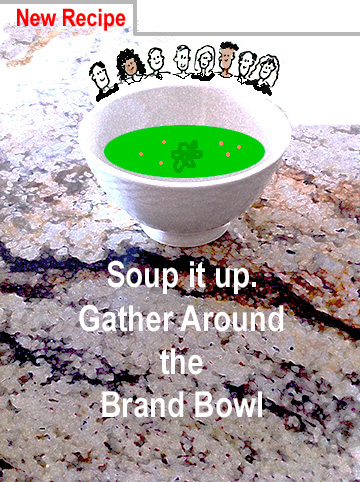A clear recipe makes all the difference.

A name should tell a story in a few words or less with pure, fresh ingredients.
After all my years of following creative briefs, sometimes veering off the path, just in case I can direct some new thinking, I am starting to want more specific details.
Many briefs are simply not digging deeply enough into the personality and lifestyle of the decision makers. Even the consumer description can be somewhat vague. Yes, data is important, but is it true to the potential name attributes and values you seek to accomplish? Will it meet the taste buds of your customer? Does your proposed name make them hungry or satisfied? What’s in your brand soup? Can you make it more delicious?
I am not always the presenter and privy to an insider’s view of what will work. In short, I don’t know all the ingredients. I’m called in to help without a full recipe. My improv creative skills are excellent, but if the ingredients are called out up front from the creative team chef, I have a greater chance of making it sing.
Some creative briefs are not even about the actual product or company. They are intentionally designed to cull results without the real product represented.
Often what clients ask for and what they end up choosing are completely divergent. Frequently clients choose a name that is completely uncreative and mainstream. They are in a comfort zone. The name feels like a dull kitchen knife cutting a tomato. Mush.
What is creative exploration about? Oftentimes the client has gone through a few rounds of internal creative and found they are not happy with the results.
Then they go outside to find solutions. Ask for the world, and then settle with a name as dry as the Sahara. How about going for a fertile name that breathes life into your venture?
Why hire a naming company when you are going to play it safe and choose names that are comparable to what you did not like in the first place? No nutritional value. No nourishment offered. No original recipe.
As someone who values the creative process, serving my clients with targeted names that are truly original, proffered from deep research and lots of life experience, I am starting to wonder what is really going on when people write these briefs. Busyness can cause people to fall back on a standard script. Perhaps a team of creative brief illuminators would help. Let’s call them ideation editors with a test kitchen. An outside consultant is ideal for this. They see things you may have overlooked. They have a fresh perspective.
A brief should be a recipe. A recipe that has all the ingredients for success built in. It should also fold in the personalities of the team. Like a restaurant, every ingredient adds something to the enjoyment of the experience. The owner, the chefs, the servers, the environment, the music, the amenities, the conversations, the acoustics, the parking. How does a brand name greet your customer? Does your customer smile when they see your brand name? What’s the legend you want your brand name to leave behind? Have you included future generations in your naming brief?
Let’s pretend for a moment you are the customer. Write your brief from this point of view. If you are a decision maker who likes warm weather as opposed to cold, someone who wants to ski rather than surf, someone who is a free spirit or a by-the-book thinker, you are going to influence name selections based on your personal preferences.
Names are not you, but you choose what comes to market. Path to purchase is directly influenced by your teams personality mash-up, and that includes me.
Put people on your team with different perspectives; stir in some feral thinkers. Have fun playing with your team. You already know they are smart, take off the reins. Sometimes a ‘team’ can be one person with multiple perspectives and lot of life experiences. Go with one person for the most cost efficiency and broadest results, someone with all nodes and neurons firing.
I think we need to spend more time getting to know one another before we start naming. Adding in the consumer variable, along with their likes and dislikes, will help create better names that people love.
The best brands don’t always stay on top as the market shifts and loyalty wanes. I recently read a review of ten top brands that are losing their appeal with consumers and why.
The 10 brands America can’t stand anymore
We need to remember we are people, not just consumers. In the moment emotions direct many purchase decisions. Loyalty is not guaranteed. Meeting a customer where they are goes a long way. Point of purchase needs to engage emotions. Making a genuine connection comes in many forms.
When writing a creative brief, add some humanness! Naming results will be more congruent, more engaging and more trustworthy. As a last note, give your team some time to marinate the ideas. Quick on the grill works, but it’s always better if you have prepped ahead with some tasty ingredients and a big dash of culturally authentic flavor. Add yourself into the mix. You matter, and I want to know who you are, what you love, and what you bring to the table.
With all of this emphasis on clean food, make sure your creative brief is not filled with processed prose. Fresh, clean directives result in fresh, clean results.
Salt to taste.
